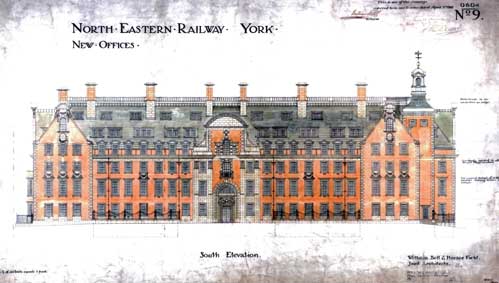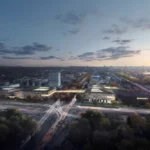Northeastern Railway Company Offices York, Mackenzie Wheeler Architects, Property architecture
Northeastern Railway Company Offices, York
Office Development in northern England – design by Mackenzie Wheeler, UK
post updated 28 June 2024
Two major new hotel projects in Yorkshire by Mackenzie Wheeler
The architecture practice has gained planning permission for two landmark schemes that will provide much needed luxury accommodation in the hotel sector for the county. The first is a brand new guest wing and a spa building for the historic Rudding Park hotel near Harrogate.
30 Jan 2009
Northeastern Railway Company Offices York
This will almost double the size of the hotel, which is set in rolling grounds created by 18th century landscape designer Humphry Repton. In complete contrast, permission has been granted for the conversion of the former Northeast Railway Company offices in the centre of York. Mackenzie Wheeler’s design will transform the neglected office building into the city’s first five star hotel.
Experience in luxury
Mackenzie Wheeler has worked in hotel and spa resort design for over 15 years, advising on areas as varied as architecture and master planning, environmental, interior and spa design.
The practice’s first spa project came in the 1990’s with Wheway Lifestyle International at the Ritz Carlton, Dubai. Recent hotel and spa work has seen Mackenzie Wheeler work as far-a-field as Cuba, Sardinia, Morocco and Jordan as well as within the UK on a variety of new build and heritage projects including the Rajvilas Spa in Jaipur, Champneys Springs in Leicestershire and the Lakeside Spa at Botleigh Grange.
Northeastern Railway Company Offices conversion
Mackenzie Wheeler’s designs for this important historic Grade 2* listed building within York will create the first five star hotel and be an important addition to the historic city’s hotel offerings portfolio. The proposal, for Acropolis Properties, seeks to remove insensitive alterations to the building and restore its heritage, while creating a hotel that can provide all that the modern visitor to York expects.
The existing building was built in 1906 as the new Northeastern Railway head office. It was designed by architects William Bell and Horace Field and until recently was still used as office space for a number of tenants. However, as time went on new additions and alterations took their toll on what was once one of the city’s premier architectural landmarks.
Mackenzie Wheeler’s proposal for the rejuvenation of the building has been influenced by its original cellular room structure. The grand open spaces on the ground and first floors of the west wing will be devoted to lobby, dining and function rooms, while all other floors are to be hotel accommodation, creating 107 guest rooms and suites, each with their own particular style and layout.
A spa is also proposed and a garden terrace area is planned for the rear of the building.
Duncan Mackenzie says: “This project is a chance to reinvigorate one of York’s important historic buildings and provide the city with a much needed five star hotel. This new use also gives public access to the interior of the building and is more appropriate than the former office use for which the building was designed, given contemporary demands for more flexible plan form office accommodation.”
The project is due to start on site in March 2009.
Location: York, North Yorkshire, England, UK
Architecture in York
York Architectural Projects
Yorkshire Building Designs – Selection
Foundation Myths at York Art Gallery
Castleford Bridge, Castleford
McDowell+Bendetti with Alan Baxter Associates and Arup
Castleford Bridge
Leeds Town Hall
Cuthbert Brodrick
Leeds Town Hall
Leeds Architecture Designs – chronological list
Key Cities near York
Comments / photos for the Northeastern Railway Company Offices York Architecture page welcome




